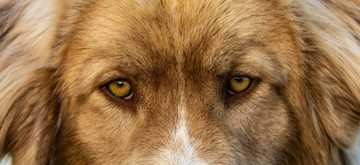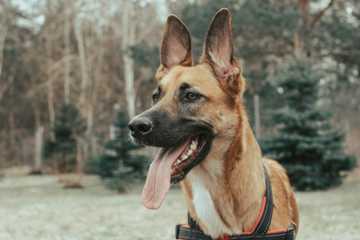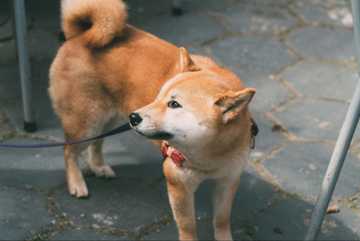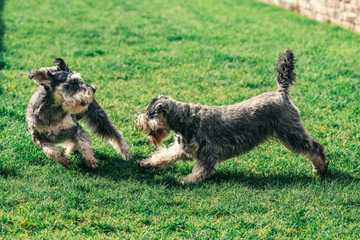Canine Body Language 101: Decode Signs of Dog Body Language

By
Woofz Team Updated on |Reviewed by
Karen PiwinskiWhat comes to mind when you hear “dog body language”? We bet you imagine a happy dog’s tail wagging or a guilty look on their face. However, reading canine body language has much more to offer: body posture, panting, dog ear position, and various facial expressions can tell you a lot about their emotional state at any given moment.
Let’s examine the most common signs of dog body language and learn how to understand the message your dog is trying to send you.
Reading Canine Body Language Signs
The key to decoding canine body signs effectively is carefully observing what your pet communicates nonverbally. You have to look at the bigger picture, interpret the whole body posture, vocalization, and individual body part movements, and consider the context of the situation. Only through such a holistic approach can you understand the true intention behind your pet’s behavior.
However, it’s still helpful to know what signs you must pay attention to and what information about your pooch's feelings they may convey.
Gaze
It’s said that the eyes are the mirror of the soul. Though we can’t understand what’s on your pet’s mind by only looking at their eyes, they can still provide valuable insight into their current emotional state.

For example, dilated pupils or showing the white part of the eye often indicate fear or excitement, while squinting (“almond-shaped” eyes with no white showing) is more common for relaxed canines.
Ear position
Your ability to read dog body language and emotions by checking the position of their ears largely depends on your pet’s breed and ear type. If your pet has erect ears, doing it is relatively simple.

Check the direction of the base of the ear: relaxed dogs bring their ears slightly back or to the side, while excited individuals keep their ears forward in the direction of the object that has caught their attention. Also, ears that are flat against the pup's head can show that they are fearful or upset.
Tail movements
Tail position and movement patterns can tell a whole story about your companion’s feelings and worries in a specific situation. To decode a dog’s tail language correctly, you should pay attention to the position of its base and how it moves. Excited canines typically hold their tails up and rapidly move them from side to side, while tucking the tail between the rear legs indicates fear.

In addition to that, a wagging tail doesn’t always mean your dog is happy or excited. It’s important to watch carefully how the dog is wagging their tail. A stiff tail wag can indicate the dog is afraid, aggressive, or unsure.
Mouth position
Now, let's discuss how to read dog body language by observing their mouth and breathing patterns. Relaxed canines often have an open mouth and soft facial expressions. They may also pant to cool themselves down.
Fearful and stressed canines often keep their mouths closed. They can also present a so-called “long-lip smile” by pulling their lips to the corners. Rapid panting is another common sign of stress.

Wrinkling the top of the muzzle to reveal front teeth is a common way to show a physical warning that can turn into aggression. It often goes hand in hand with a tense gaze and a furrowed forehead. You can observe such behavior in canines protecting their food and territory.
Overall body posture
Understanding the hidden message behind canine posture is helpful when socializing with other dogs. For example, you can see that your pooch is playful because they have loose and wiggly body movements. If your companion is stiff during the interaction and keeps moving in the opposite direction, they’re probably not interested in play.

Scared canines often tremble, lean away, or lower their head and chest. In extreme cases, your dog may freeze or urinate when you approach them. Canine aggression can manifest in a tense body position and an attempt to appear larger by raising the head above the shoulders.
How to Understand Dog Body Language and Emotions
Let’s explore canine body language basics and discuss some emotional states pet owners can differentiate using nonverbal cues.
Stressed dog body language
It’s possible to tell whether your dog is stressed or nervous by looking only at their behavior. When distressed, canines try to look away and avoid direct eye contact with the trigger. They may also start yawning or self-grooming excessively, or shaking their bodies as they do when their coat is wet.
However, displacement behaviors that aim to self-regulate a canine are the most telling signs of stress.
When canines attempt to self-calm, they:

- Turn away
- Move slowly
- Freeze
- Lick their lips
- Smack their lips
- Scratch
- Start sniffing the ground
Bored dog body language
Like humans, canines are prone to boredom. Lack of mental stimulation is often at the core of disruptive behaviors. That’s why it’s vital to recognize boredom and offer your canine companion an appropriate alternative.
Signs of boredom in canines are:
- Excessive chewing
- Digging and scratching the furniture
- Barking or whining
- Obsessive spinning and tail chasing
- Pacing around the house
Aggressive dog body language
Numerous factors can cause canines to act aggressively. Regardless of the cause, aggression manifests itself through a set of standard signs. Mostly, a dog’s posture gets stiff, the fur on their back raises, and the body gets into a stiff-legged “ready” stance.
Aggressive canines usually demonstrate:

- A fixed gaze concentrated on the trigger of an aggressive response
- A raised upper lip, teeth showing, and wrinkles around the muzzle
- A tucked tail (in fearful dogs) before the act of aggression or a tail held high and a tight wag (in confident aggressive canines)
Dominant dog body language
A dominant canine displays strong and positive body language. They appear slightly rigid, keeping their tails up and even growling softly. Such behavior is typical for dogs encountering visitors in their territory.

Dominant behaviors include:
- Direct eye contact
- Wagging tail
- Raising fur
- Keeping the mouth closed
Appeasement dog body language
Appeasement body language signifies submissive behavior, often an attempt to appear less threatening. Canines that demonstrate appeasement can lower their bodies or expose their bellies.
Appeasement signs include:
- Pinned back ears
- Squinting eyes
- Avoiding eye contact
- “Appasement grin” through revealing front teeth
- Frequent muzzle licking
- Tucked tail or slow, tight wag
Playful dog body language
Knowing when your dog is playful is essential for initiating playtime, especially when you want to socialize your pet with other canines.

Here's how to tell that your dog is playful:
- Front legs are stretched, and rear legs are up to form a “play bow”
- Eyes are soft, and ears are relaxed
- Wagging the tail loosely
Body language of dog in pain
When in pain, canines exhibit specific changes in behavior. Some symptoms are more prominent than others, but an experienced owner can often tell when their pet requires medical attention by closely observing their behavior.
A dog communicates physical discomfort and pain when they:
- Arch back
- Avoid being touched
- Shake or tremble
- Pant excessively
- Whimper, cry, or howl
- Hold the head below the shoulders
Dog’s relaxed body language
Relaxed canines typically present soft, non-rigid postures. Their facial expressions are calm, and their eyes are soft. You can easily tell from their demeanour that they’re carefree and relaxed.

A relaxed and happy dog will:
- Keep their ears in the natural position
- Squint their eyes
- Close their mouth or open it slightly
- Pant in a relaxed way
- Wag the tail widely and loosely
Scared dog body language
Some dogs are naturally predisposed to fearful reactions. For others, these results stem from a traumatic past event or a specific stimulus. However, for a pet owner, it’s essential to learn a fearful dog’s behavior patterns to help them overcome the fear.
Here are some of the signs of fear in canines:
- Slight or major cowering
- Licking lips
- Panting
- Moving the ears to the side
- Looking in many directions
- Frequent yawning
- Pacing
- Moving slowly
Wrap Up
Deciphering dog body language is essential for improving canine communication with your pet and adequately responding to their needs. To interpret these individual signs correctly, you must always consider the overall posture and the circumstances when the specific behavior appears. Learning the fundamentals of canine body language will provide you with the necessary skills to grow your human-dog bond and build a strong foundation for a harmonious relationship.